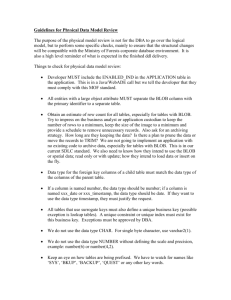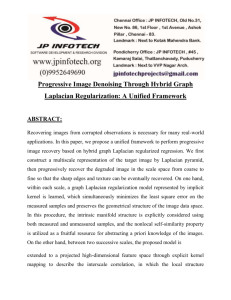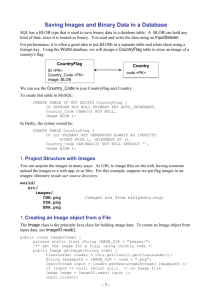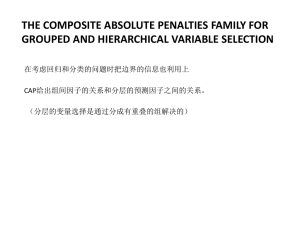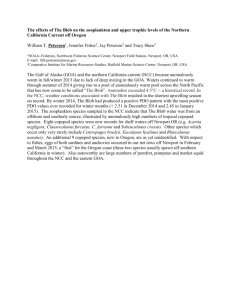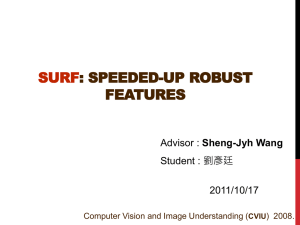February 20 lecture
advertisement
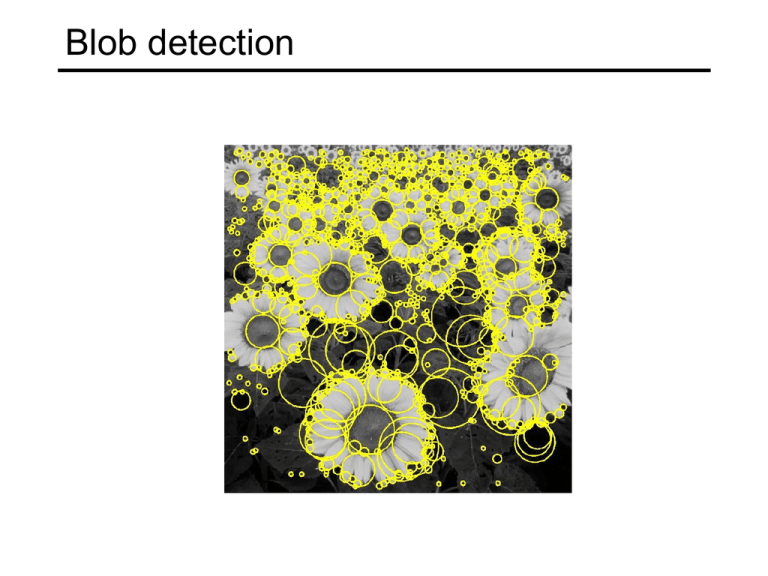
Blob detection Feature detection with scale selection • We want to extract features with characteristic scale that is covariant with the image transformation Blob detection: Basic idea • To detect blobs, convolve the image with a “blob filter” at multiple scales and look for extrema of filter response in the resulting scale space Blob detection: Basic idea minima * = maxima Find maxima and minima of blob filter response in space and scale Source: N. Snavely Blob filter Laplacian of Gaussian: Circularly symmetric operator for blob detection in 2D g g g 2 2 x y 2 2 2 Recall: Edge detection f d g dx d f g dx Edge Derivative of Gaussian Edge = maximum of derivative Source: S. Seitz Edge detection, Take 2 f Edge 2 Second derivative of Gaussian (Laplacian) d g 2 dx d2 f 2g dx Edge = zero crossing of second derivative Source: S. Seitz From edges to blobs • Edge = ripple • Blob = superposition of two ripples maximum Spatial selection: the magnitude of the Laplacian response will achieve a maximum at the center of the blob, provided the scale of the Laplacian is “matched” to the scale of the blob Scale selection • We want to find the characteristic scale of the blob by convolving it with Laplacians at several scales and looking for the maximum response • However, Laplacian response decays as scale increases: original signal (radius=8) increasing σ Scale normalization • The response of a derivative of Gaussian filter to a perfect step edge decreases as σ increases 1 2 Scale normalization • The response of a derivative of Gaussian filter to a perfect step edge decreases as σ increases • To keep response the same (scale-invariant), must multiply Gaussian derivative by σ • Laplacian is the second Gaussian derivative, so it must be multiplied by σ2 Effect of scale normalization Original signal Unnormalized Laplacian response Scale-normalized Laplacian response maximum Blob detection in 2D Laplacian of Gaussian: Circularly symmetric operator for blob detection in 2D Scale-normalized: g g g 2 2 y x 2 2 norm 2 2 Scale selection • At what scale does the Laplacian achieve a maximum response to a binary circle of radius r? r image Laplacian Scale selection • At what scale does the Laplacian achieve a maximum response to a binary circle of radius r? • To get maximum response, the zeros of the Laplacian have to be aligned with the circle • The Laplacian is given by (up to scale): ( x y 2 ) e 2 2 2 ( x 2 y 2 ) / 2 2 • Therefore, the maximum response occurs at r / 2. circle 0 r Laplacian image Characteristic scale • We define the characteristic scale of a blob as the scale that produces peak of Laplacian response in the blob center characteristic scale T. Lindeberg (1998). "Feature detection with automatic scale selection." International Journal of Computer Vision 30 (2): pp 77--116. Scale-space blob detector 1. Convolve image with scale-normalized Laplacian at several scales Scale-space blob detector: Example Scale-space blob detector: Example Scale-space blob detector 1. Convolve image with scale-normalized Laplacian at several scales 2. Find maxima of squared Laplacian response in scale-space Scale-space blob detector: Example Efficient implementation • Approximating the Laplacian with a difference of Gaussians: L 2 Gxx ( x, y, ) G yy ( x, y, ) (Laplacian) DoG G ( x, y, k ) G ( x, y, ) (Difference of Gaussians) Efficient implementation David G. Lowe. "Distinctive image features from scale-invariant keypoints.” IJCV 60 (2), pp. 91-110, 2004. From feature detection to feature description • Scaled and rotated versions of the same neighborhood will give rise to blobs that are related by the same transformation • What to do if we want to compare the appearance of these image regions? • Normalization: transform these regions into samesize circles • Problem: rotational ambiguity Eliminating rotation ambiguity • To assign a unique orientation to circular image windows: • • Create histogram of local gradient directions in the patch Assign canonical orientation at peak of smoothed histogram 0 2 SIFT features • Detected features with characteristic scales and orientations: David G. Lowe. "Distinctive image features from scale-invariant keypoints.” IJCV 60 (2), pp. 91-110, 2004. From feature detection to feature description Detection is covariant: features(transform(image)) = transform(features(image)) Description is invariant: features(transform(image)) = features(image) SIFT descriptors David G. Lowe. "Distinctive image features from scale-invariant keypoints.” IJCV 60 (2), pp. 91-110, 2004. Properties of SIFT Extraordinarily robust detection and description technique • Can handle changes in viewpoint – Up to about 60 degree out-of-plane rotation • Can handle significant changes in illumination – Sometimes even day vs. night • Fast and efficient—can run in real time • Lots of code available Source: N. Snavely Affine adaptation • Affine transformation approximates viewpoint changes for roughly planar objects and roughly orthographic cameras Affine adaptation Consider the second moment matrix of the window containing the blob: I x2 M w( x, y ) x, y I x I y IxI y 0 1 1 R R 2 I y 0 2 direction of the fastest change Recall: u [u v] M const v (max)-1/2 direction of the slowest change (min)-1/2 This ellipse visualizes the “characteristic shape” of the window Affine adaptation example Scale-invariant regions (blobs) Affine adaptation example Affine-adapted blobs
